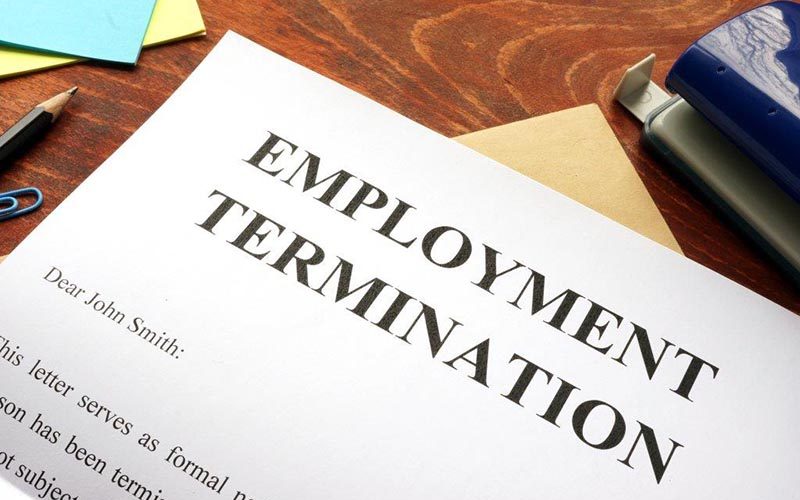Being fired or unlawfully terminated from a job can cause a significant amount of financial hardship in your life. If you believe you were fired for a cause that was not legitimate, you may be entitled to compensation. Workers can file a wrongful termination complaint if they were fired on improper or criminal grounds. If you win a wrongful termination lawsuit, you may be able to get compensation to help with the financial burden of losing your work. It’s possible that you’ll be able to return to your previous position. So, let’s discuss on wrongful termination lawyer that will help you seek justice after being wrongfully terminated.
Wrongful Termination
Although many people who are fired believe their dismissal was “wrongful,” especially if it was done without cause, the legal definition of wrongful dismissal is fairly specific. Being dismissed for an illegal reason, such as violating federal anti-discrimination legislation or breaching a contract, is being wrongfully terminated. An employee, for example, cannot be sacked because of her color, gender, ethnicity, religion, or disability. It’s also against the law to fire an employee for filing a legal complaint against the company or for reporting the employer’s wrongdoing as a whistleblower. Such actions are considered “retaliation” and are therefore illegal. The Wrongful Termination section of FindLaw discusses what “at-will” employment means, and how to tell if you have an implied employment contract. What constitutes wrongful termination, and how to bring a lawsuit against an employer.
Do You Need a Wrongful Termination Lawyer?
Although most Americans are employed “at will,” meaning they can be fired for any reason or no reason at all a slew of federal and state regulations prohibit dismissal for discriminatory reasons or in retribution for reporting certain types of misconduct. In addition to these statutory safeguards, most states offer a “public policy” exception that protects employees who are sacked in a way that is likely to do harm to the community. If employees can be for revealing a public health issue, for example, fewer employees will disclose such dangers.
Rather than being codified as formal laws, public policy exceptions are enforced and occasionally enlarged by courts on a case-by-case basis. If you were for doing “the right thing” (or refusing to do the wrong thing). But don’t have a strong enough case for statutory remedies, a public-policy claim might be your best hope. A wrongful discharge case, often known as a discrimination lawsuit, may be able to help you reclaim your job.
The Employment Law Group law company has represented employees in wrongful termination lawsuits all around the United States. Our firm can assist you in resolving your claims, whether you were sacked for refusing to do something unethical or for reporting a coworker’s illegal behavior.
Steps to Take after Being Wrongfully Terminated from a Job
Below, we will discuss five steps to take if you are wrongfully terminated from your job to preserve any legal claims you may have against your former employer.
#1. First, calm down
Avoid expressing unneeded resentment or fury; even if you’re bitter, and desperate, and, strive to remain calm and optimistic. You may be in for a long flight, and you must remain cool and focused on reclaiming what is rightfully yours.
Additionally, avoid making hasty decisions, such as sending a derogatory email to your former employer or acting irrationally. It’s also critical that you avoid the impulse to retaliate or “get even” with your employer by destroying company property, stealing items, or publicly harassing bosses. Apart from the possibility of civil or criminal litigation being brought against you. Such activities will harm your case and make it more difficult to recover damages.
It’s important to realize that none of these steps will assist you in overturning your boss’s decision. As a result, making a big deal about it is pointless. The most important thing you should concentrate on is enforcing your employment rights in court. which an expert California employment attorney can assist you with.
#2. Take a look at what happened: Seek an explanation from the company
The next step should be to figure out why you were fired and what factors contributed to your dismissal. When you’re fired, your boss or supervisors may give you a rationale for why you were fired. However, there could be more serious, and frequent criminal reasons that you are unaware of but suspect.
Employees may not be fired for discrimination, harassment, retaliation, or breach of contract, according to California law. (2000) 24 Cal.4th 317, 336 Guz v. Bechtel National, Inc. Firing an employee for reasons that contradict public policy or express terms of state or federal statutes. The Labor Code is likewise illegal. Atlantic Richfield Co. v. Tameny, 27 Cal.3d 167, 170 (1980).
You may be able to sue if you were sacked for any of these reasons, or more than a California wrongful termination lawyer can explain. This is why you should investigate the real reasons for your termination.
It could be as simple as asking the firm why you were sick or contacting the individual who signed the termination letter to find out. It would be more helpful if you could get ahold of your personnel file to see if they had previously issued a warning. Everything you learn from them will aid you in determining whether or not your termination was justified.
#3. Start collecting your evidence
The amount of evidence offered in each wrongful termination lawsuit determines its success. If you did step 2 correctly, you are most likely already aware that your termination was illegal. With this in mind, gather as much evidence as possible to help your argument succeed.
The emphasis on evidence is straightforward. Wrongful termination lawyers frequently revolves around statements of fact made by both the employer and the employee. Frequently, the employer claims one legal basis for your termination while you claim another. The quality of evidence you can present is what makes your story credible. Alameda Newspapers, Inc. v. Eisenberg (1999) 74 Cal.App.4th 1359, 1386.
You should look for evidence that you believe will back up your claims. You are free to utilize all of your emails, text messages, voicemail messages, and images. Also, you should also call any eyewitnesses to critical situations, such as a sexual overture from your boss. Eyewitness accounts, especially when backed up by written proof, can provide credibility to your case.
Start writing up your own account of events as soon as you’re able, adding as much information as possible leading up to your wrongful termination lawyer. Include all you can recall, including dates, people’s names, the locations of important events, and the order in which they occurred. It’s always a good idea to start writing your account within a few days of getting it. This is due to the fact that memory deteriorates over time.
#4. File a complaint with the appropriate regulatory agency
There are many different forms of employment law complaints that can be, and they can be by a number of different bodies. The following are some of the most typical claims and agencies where you can file:
#1. Discrimination, retaliation or harassment
Claims are typical with the Equal Employment Opportunity Commission (EEOC) or the California Department of Fair Employment and Housing (California Department of Fair Employment and Housing) (DFEH). The Equal Employment Opportunity Commission (EEOC) enforces federal laws against discrimination, retaliation, and harassment. Such as the Americans with Disabilities Act and the Civil Rights Act. The Department of Fair Employment and Housing (DFEH) is in charge of enforcing California’s Fair Employment and Housing Act.
#2. Unsafe workplace complaints
You may submit a complaint with the Occupational Safety and Health Administration if you were sacked after voicing a complaint about harmful work practices (OSHA). The Department of Occupational Safety and Health in California is the equivalent (DOSH).
#3. Whistleblower complaints
You can submit a complaint with the US Department of Labor if you were sacked as a result of protected activity under the Sarbanes-Oxley Act.
#4. Equal pay complaints
If you were sack for raising concerns under the Equal Pay Act, you can file a claim with the Equal Employment Opportunity Commission (EEOC). You can also submit a claim under the California Equal Pay Act with the California Labor Commissioner’s Office.
These agencies have broad authority to investigate the facts of your complaint and, if appropriate, impose administrative fines. They may also attempt to assist you in reaching an agreement with your employer or file a lawsuit against them.
Regardless of the exact legislation under which you are seeking remedy, you may opt to file with either of these agencies. For instance, you can file a discrimination, retaliation, or harassment complaint with either the EEOC or the DFEH.
Your wrongful termination lawyer will explain how these possibilities affect your case and which path to compensation is best for you.
#5. Finally, let your attorney file a lawsuit
Individuals frequently launch a lawsuit after the regulating body has failed to negotiate a settlement, or because they chose to bring a lawsuit first. In either scenario, your lawyer will be present to explain the steps involved in bringing an employment lawsuit and what to expect.
A professional employment lawyer will review the circumstances of your case and determine whether or not you have a strong case. They will also advise you on whether it is better to negotiate a settlement rather than file a lawsuit against your previous employer. If you settle the matter, you may be able to move on from the firing and resume your life. However, you will be unable to sue your employer in the future based on the same facts.
Depending on your circumstances, taking the case to trial may be more advantageous. In such circumstances, the court may award compensation in the form of back salary and benefits that you would have received if you hadn’t been fired. If you choose to stay with the company, you may be eligible for reinstatement from your previous position.
It’s vital to remember that you have various choices for enforcing your rights, and you can use any of them. Take your employer’s explanations for your termination with a grain of salt, especially if you suspect fraud. If something doesn’t feel right, speak with an employment lawyer straight away.
What are the Grounds for Wrongful Termination in Texas?
In the state of Texas, public employee has the right to file a lawsuit for wrongful termination if they have been fired solely for refusing to carry out an illegal act. “Illegal conduct” is any action that, if committed, would subject the perpetrator to criminal prosecution under either state or federal law. Workers who are employed by private businesses are not afforded this protection.
Can I Get Tired Without Warning in Texas?
In the absence of an express agreement to the contrary, the “employment at will” doctrine is the fundamental rule in the state of Texas. This doctrine states that either party in an employment relationship has the right to terminate the relationship or change the terms and conditions of employment at any time for any reason, or even for no particular reason at all, with or without notice.
Can I Sue My Employer for Wrongful Termination?
If your employer has acted in a manner that is contrary to its contractual obligations, such as by failing to give notice in accordance with the entitlement outlined in your contract of employment, then your employer becomes liable to pay you damages for wrongful dismissal. These damages will take into account any and all losses you have incurred as a result of your termination of employment.
Do Employers Have to Give Reasons for Dismissal?
Your employer owes it to you to explain the reasons for your termination. You have the legal right to have a written explanation, and this should be in the form of a letter or an email if you are pregnant or have worked there for at least two years. According to the law, if you are fired for a reason that is considered to be “automatically unjust,” it is always unfair.
What is a Fair Process for Dismissal?
If an employer wants to fire an employee due to their capability (performance), they are expected to follow a fair procedure first. This procedure is likely to include putting the employee on a formal performance improvement plan, providing them with some attainable goals, reviewing their progress on a regular basis, and providing them with additional training.
How wrongful termination Lawyers Charge
There are several different types of attorney fee structures, which are primarily by the type of counsel you require. The following are brief examples of some of the more typical ways that lawyers are encouraged in their work.
#1. Hourly Fees
Every attorney charges an hourly fee, which is a fixed amount charged by the attorney for each hour of work performed under hourly fee arrangements. These hourly charges differ greatly from one city to the next and from one lawyer to the next. However, hourly rates typically range from a few hundred dollars to several thousand dollars or more.
If you’re looking for a single, isolated service, an hourly price model may make the most sense. If you simply want a lawyer to review a severance agreement.
#2. “Unbundling” of Services
The “unbundling” of services is a recent trend in legal fee arrangements. Previously, clients would employ a lawyer on a “retainer” basis to perform services as needed. This was more prevalent among commercial clients, but a person may occasionally employ a lawyer to assist with all parts of a situation, such as wrongful termination. For example, the client could need help appealing a refused unemployment insurance claim or dealing with other government authorities. As well as examining potential legal claims and initiating a lawsuit.
You can employ a lawyer for a specific service (for example, filing a claim for unpaid wages with your state’s labor commissioner). But not for any other services related to your termination. If the original attorney agrees to take on the new work. You have the option of engaging a separate lawyer for other services or expanding the services of the original attorney (with a new fee agreement). Unbundled legal services are usually charged on an hourly basis.
#3. Contingent Fees
If your case warrants bringing a lawsuit, the lawyer may agree to a contingency fee, with or without a retainer, on a case-by-case basis. Essentially, a contingent fee is a percentage of your recovery. The lawyer receives a cut if you win. However, if you do not receive a monetary award or settlement, the lawyer will not be paid.
The most frequent contingency agreements involve percentages of either a post-trial damages award or a pre-trial settlement amount. The proportion a lawyer charge varies by area, just like hourly costs. However, in most cases, a contingent fee of one-third of any pre-trial recovery is standard. when a trial date is set or another marker of the start of litigation is established. The lawyer’s percentage often rises. The explanation for the increase is that when a lawsuit is ready to begin, the attorney’s hours increase considerably.
A retainer, or lump-sum payment of fees, may be requested by the lawyer at the start of the contingent fee arrangement. This is the lawyer’s “downside” insurance: a small fee for taking the case on a contingency basis.
#4. Retainers
Retainers are in a variety of fee arrangements by lawyers, not just contingent fee retainers. A lawyer may request a “refundable” retainer, which means you will credit for your payment and the retainer amount will be from the lawyer’s contingent fee (if you win or settle). A lawyer may request a retainer in exchange for hourly fees. Then remove only the fees actually received from the retainer amount. With accounting to you for the amount withdrawn and the amount remaining. If there is any money remaining in the retainer at the end of the lawyer’s representation. The unpaid amount will be refunded to you.
Alternatively, the lawyer may request a “cost retainer” to cover non-fee charges like filing fees, deposition costs, expert witness fees, and so on. In most cases, the lawyer will take money from the fund as needed to cover unexpected expenses, and you will be informed of the amount removed and the balance remaining in the account.
What are the Odds of Winning a Wrongful Termination Lawsuit?
The price of maintaining a website can be anywhere from $5 to $5,000 each month, which works out to $60 to $60,000 per year on average. Keeping extraordinarily huge and popular websites like Amazon or Netflix running needs considerably more money to maintain. There are a lot of different aspects that go into determining the total cost of maintaining your website, and the platform, features, and services of the website are some of those factors.7 days ago
What to Do When You Are Being Pushed Out of Your job?
In as little as 12 to 18 months, a website that was created from scratch has the potential to move from generating nothing to earning $1,000, $2,000, or even $5,000 per month with the help of the appropriate niche topic. Building and then selling websites to portfolio investors is an unheard-of business concept that has been gaining pace recently. This is a business plan that is less well-recognized.
Is Termination the Same as Firing?
On the other hand, you should anticipate that the initial cost of building a website will be close to $200 and that the continuous cost of maintaining it will be close to $50 a month on average. If you decide to engage a designer or developer, this estimate will increase; you may anticipate an initial price of approximately $6,000, as well as a continuing cost of $1,000 per year.
Can I Get a Domain Name for Free Forever?
You have the option of going with a free domain name registrar if all you care about is finding a registrar that will provide you with a completely free domain name forever. On the other hand, this might lead to domain extensions that appear to be less trustworthy, such as. tk, as opposed to the more common.com extension. For this reason, we do not recommend this choice for use by smaller companies.
FAQ
Is it hard to prove wrongful termination?
For a wrongful termination lawsuit to be successful, you’ll need to prove that your manager and/or employer acted with illegal motives. This can be a difficult task as employers and managers will rarely admit they had illegal motives when they fired you.
What qualifies as wrongful termination?
To be wrongfully terminated is to be fired for an illegal reason, which may involve a violation of federal anti-discrimination laws or a contractual breach. For instance, an employee cannot be fired on the basis of her race, gender, ethnic background, religion, or disability.
Is it worth it to sue your employer?
If you sue your employer, it won’t be enough for you to prove that your employer made the wrong decision, or even that your employer was a no-goodnik. If you don’t have a valid legal claim against your employer, then you will ultimately lose your case. One big reason to think twice before you sue.
{
“@context”: “https://schema.org”,
“@type”: “FAQPage”,
“mainEntity”: [
{
“@type”: “Question”,
“name”: “Is it hard to prove wrongful termination?”,
“acceptedAnswer”: {
“@type”: “Answer”,
“text”: “
For a wrongful termination lawsuit to be successful, you’ll need to prove that your manager and/or employer acted with illegal motives. This can be a difficult task as employers and managers will rarely admit they had illegal motives when they fired you.
“
}
}
, {
“@type”: “Question”,
“name”: “What qualifies as a wrongful termination?”,
“acceptedAnswer”: {
“@type”: “Answer”,
“text”: “
To be wrongfully terminated is to be fired for an illegal reason, which may involve a violation of federal anti-discrimination laws or a contractual breach. For instance, an employee cannot be fired on the basis of her race, gender, ethnic background, religion, or disability.
“
}
}
, {
“@type”: “Question”,
“name”: “Is it worth it to sue your employer?”,
“acceptedAnswer”: {
“@type”: “Answer”,
“text”: “
If you sue your employer, it won’t be enough for you to prove that your employer made the wrong decision, or even that your employer was a no-goodnik. If you don’t have a valid legal claim against your employer, then you will ultimately lose your case. One big reason to think twice before you sue.
“
}
}
]
}






